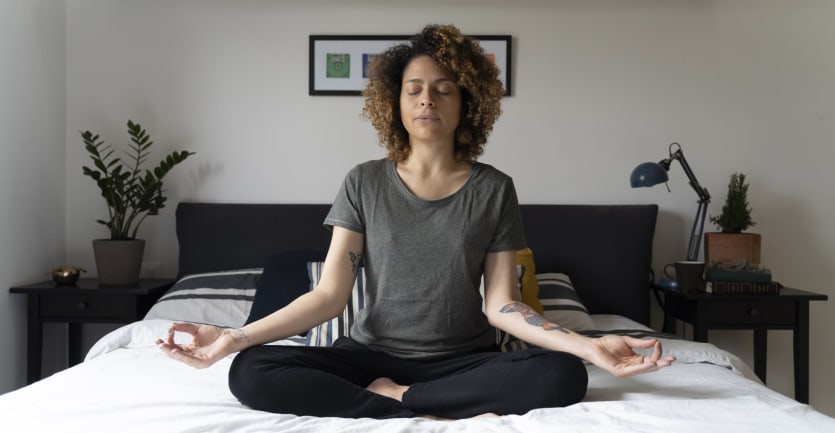The Benefits of Meditation for College Students
- Meditation reconnects you with what is present and vital in your experience
- Meditation is scientifically proven to enhance physical health and mental well-being
- In college, meditation can help you improve concentration, memory, and learning
Think back on the last few hours of your day. What color was the sky when you were outside? What did campus sound like: Did you hear anyone laugh, a dog bark, or birds sing? Did the fabric of your clothes feel soft on your skin, or did the air feel warm or cool on your face?
To Buddhist monk and meditation master Thich Nhat Hanh, those moments are little miracles. “Every day we are engaged in a miracle which we don’t even recognize,” he wrote. It’s our job to notice and appreciate life’s small moments, but particularly in these challenging times, it’s hard to remain focused when so much noise competes for our attention.
“Meditation is not passive sitting in silence. It is sitting in awareness, free from distraction, and realizing the clear understanding that arises from concentration.”. Source: —Thich Nhat Hanh
Meditation can help us relax into the present moment. By allowing ourselves to listen and feel deeply, meditation reveals the little miracles that occur throughout the day. Simply by being still and accepting what happens, we can become more focused and less anxious. We can also sharpen our memory and increase our patience.
Meditation doesn’t only make us more peaceful; it can also help us be more successful in all life endeavors. For students, it can help them study more efficiently, improve recall during tests, and decrease the stress of difficult situations. Not bad for sitting still!

The Scientific Benefits of Meditation
For more than five thousand years, people across the world and from various cultural traditions have practiced meditation. In recent decades, the science has caught up with the practice. Studies have shown that meditation offers relief from stress, depression, anxiety, and even chronic pain. One Harvard study showed that participants who meditated for 15 minutes a day over an eight-week period lowered their blood pressure.
MRI scans prove that meditation creates changes to the physical structure of a brain. It changes how our minds process information. After eight weeks of a daily meditation practice, the amygdala — the brain’s “fight or flight” center — begins to shrink.
The pre-frontal cortex, which helps us make decisions and concentrate, also thickens. This helps us become less reactive and more focused, even when we’re not meditating. These effects can be especially important for college students, whose lifestyles demand constant connectivity and perpetual information processing.
[Meditation] changes how our minds process information. After eight weeks of a daily meditation practice, the amygdala — the brain’s “fight or flight” center — begins to shrink.
Paul Kjellberg, a professor of philosophy at Whittier College, teaches classes in meditation and sees a special need for meditation on campus: “There’s been a huge shift in last 15 or 20 years with technology and phones,” Kjellberg said. “[Students] have great difficulty getting away from their phones, but they’re also aware of the deleterious effects that the phones have on their lives.”
Meditation becomes a daily date with oneself to be phone-free and disconnected, to give our brains a break to help them process information more efficiently. Kjellberg encourages students to make meditation a part of a daily routine in order to create a habit that sticks.
Do you already wake up early for a jog? Tack on a meditation session after that to create time for stillness, rest, and deep relaxation. Joining one new habit with an established one can help it take hold.
How to Start a Meditation Practice in College
College presents challenges to meditation: crowded dorms, crowded schedules. Even minds are crowded with thoughts, plans, memories, and stressors. Buddhists call this “monkey mind.” Picture a monkey, swinging from one branch to the next, never wanting to rest. That monkey is our brain.
To calm the monkey, you’ll need a place that’s set apart. It doesn’t have to be perfectly quiet, but it should be peaceful. If quiet is impossible among your roommates or family members, try noise-cancelling headphones.
Some colleges have meditation rooms, or you might find a quiet library study room or an unbooked conference room. You may even find a meditation group on your campus through your wellness center or an interfaith group. Meditating in nature can also induce calm and deepen your practice.

To begin meditation, sit comfortably. Meditators usually sit in a chair or cross-legged on the floor, although meditation is also possible while lying down, standing, or walking around. When practicing sitting meditation, be sure to sit in a relaxed but upright posture, so that your head is resting on the top of your spine.
Then, determine how long you want to meditate each day. Fifteen minutes is ideal, but you may want to to start with just 5-10 minute intervals. Before starting, commit to your practice. For the duration of the meditation, set your intention to be physically still while gently noticing any kind of tension that arises in your body.
Ready to begin? You’ve got choices.
Types of Meditation Practices
The goal of meditation is to be aware of the present moment. It sounds easy, but monkey mind is powerful, constantly swinging us into the past and future. To keep focused, you can use several meditation techniques and find one that works well for you:
 Breath Awareness
Breath Awareness
Meditators have a simple reason for focusing on the breath: It grounds us in our bodies. If we stay with the breath — each inhale, each exhale — then we stay connected with the present moment.
Don’t control your breath, but remain curious about it. Follow the flow of air as it passes through you; feel the air hit your nostrils, fill your lungs, and go out again. Thich Nhat Hanh wrote, “Breath is the bridge which connects life to consciousness, which unites your body to your thoughts. Whenever your mind becomes scattered, use your breath as the means to take hold of your mind again.”
 Body Scan
Body Scan
Start at the top of your head. Pay attention to sensations, any feelings of tightness or resistance. Can you relax this area at all? Then work down to your forehead, and again pay attention to sensations and tightness, relaxing that area.
Work your way down slowly — focusing on your eyes, cheeks, jaw, neck, shoulders, arms, chest, abdomen, fingers — down to your toes. Just like a breath meditation, this practice grounds you in the present moment, and it creates a systematic way to release you from the stress your body holds from the past.
 Guided Meditation
Guided Meditation
If you’re struggling with focus, try a guided meditation. Guided meditations are available on apps (suggestions are below) and can be geared toward many types of goals, like sleep, focus, happiness, confidence, and relaxation. Some have background music and sounds, some do not. Some involve word repetition, and others you’ll listen to silently. Try different types to find a guided meditation that matches your personality and needs.
Whatever method you choose, remember to be gentle with yourself and comfortable with beginning again. Your mind will wander. That’s part of the process. When it does, think to yourself, “That’s okay! Begin again!” You may skip a few days. “That’s ok! Begin again!” This is not about the art of perfection. Meditators often joke that there’s a reason meditation is called a “practice.” It’s the eternal practice of beginning again.
Meditation Resources for Students
Apps can be a wonderful resource for beginners and those with established practices. Insight Timer has a wealth of resources, and nearly all of them are free. You can filter 24,000 guided meditations by the amount of time you have to meditate and your goal for meditation. You can find ending bells that sound like Buddhist ringing bowls (a much nicer sound than a phone alarm). You can even connect with friends to create group meditation sessions from afar.
Headspace will deliver a meditation to you daily. You can start with a 10-day beginner’s course, and then choose from other courses, bedtime exercises, and even sleep sounds. While the app costs about $70 a year, they offer a generous student discount of $9.99 per year.

As for books, “Mindfulness in Plain English” by Bhante Henepola Gunarantana is a favorite among beginners, answering the questions that we can be afraid to ask, such as, “How soon will I notice changes?” and “What do I do when my back hurts?” For a funny read, try “10% Happier”, which tells how journalist Dan Harris overcame his cynicism to become a daily meditator.
The most powerful resource will be your habit, however. Meditation can feel silly at first, just sitting there and doing nothing. If you stick with it, though, it may become the most productive time of your day. It may make the rest of your day more focused and relaxed, and show you the little miracles that are all too easy to miss.